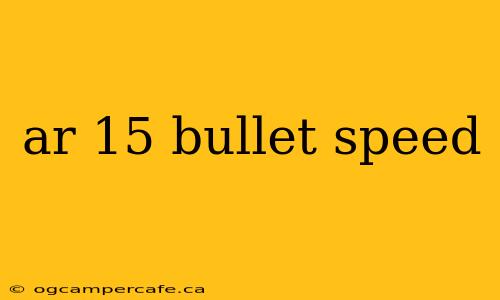The speed of a bullet fired from an AR-15 rifle is a complex topic, influenced by several factors beyond just the firearm itself. Understanding these variables is crucial for safe and responsible firearm handling, as well as for appreciating the ballistic capabilities of the platform. This guide will delve into the specifics of AR-15 bullet velocity, exploring the key influencing factors and providing a clearer picture of what to expect.
Factors Affecting AR-15 Bullet Speed
Several factors significantly impact the muzzle velocity—the speed at which a bullet leaves the barrel—of an AR-15:
1. Cartridge Type: The Foundation of Velocity
The most significant factor is the type of cartridge used. AR-15s are chambered in a variety of calibers, each with its own distinct ballistic profile. Common cartridges and their approximate muzzle velocities (in feet per second, fps) include:
-
.223 Remington/5.56 NATO: Typically ranges from 2,800 fps to 3,200 fps, depending on the specific ammunition load (grain weight and powder charge). This is the most common cartridge for AR-15s.
-
.300 Blackout: Offers subsonic and supersonic options. Subsonic rounds typically fall below 1,100 fps, while supersonic loads can reach velocities around 2,300 fps. This cartridge is known for its versatility.
-
6.8 SPC: Generally delivers velocities between 2,600 fps and 2,800 fps, providing a balance between velocity and heavier bullet weight.
-
6.5 Grendel: Known for its accuracy and longer range, this cartridge boasts muzzle velocities typically ranging from 2,600 fps to 2,800 fps.
Important Note: These are approximate ranges. Actual velocities can vary based on the specific manufacturer, lot, and even individual rounds within a single box.
2. Barrel Length: The Acceleration Zone
Barrel length plays a crucial role in bullet acceleration. A longer barrel allows more time for the expanding propellant gases to push the bullet, resulting in a higher muzzle velocity. Shorter barrels result in lower velocities. The relationship isn't perfectly linear, but the trend is clear: longer is faster (within reason).
3. Ammunition Load: Powder and Projectile Weight
The specifics of the ammunition itself – the bullet weight (grain weight) and the type and amount of gunpowder used – heavily influence velocity. Heavier bullets generally travel slower than lighter bullets with the same powder charge, while a larger powder charge will increase velocity for a given bullet weight.
4. Environmental Conditions: Temperature and Altitude
Environmental conditions also subtly affect bullet velocity. Higher temperatures generally lead to slightly higher velocities, while lower temperatures and higher altitudes can decrease them. These effects are usually less significant than the factors mentioned above.
Understanding the Impact of Bullet Speed
Knowing the velocity of your ammunition is important for several reasons:
-
Accuracy: Bullet speed directly impacts trajectory and accuracy, especially at longer ranges.
-
Energy Transfer: Higher velocity generally translates to more energy transferred to the target upon impact.
-
Safety: Understanding the ballistic capabilities of your firearm is fundamental to safe handling and responsible shooting practices.
Disclaimer:
This information is for educational purposes only. Always consult your firearm's manual and practice safe gun handling techniques. Always prioritize safety when handling firearms and ammunition. This information should not be considered professional advice. Always consult a qualified firearms expert for specific questions or concerns.
